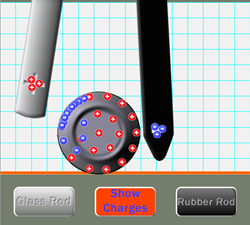 Polarization
Polarization
Resource:
Physics Interactives: Aluminum Can Polarization
Student Exercise: Aluminum Can Polarization
Grade Level: High School
Description:
This simulation helps learners visualize the underlying cause for the attraction between a charged and an uncharged object. A charged object (a glass rod or rubber rod) can be placed near a neutrally-charged conductor (aluminum can). Students can move the charged objects around the conductor to see the response of electrons depicted in the model. The Student Exercise asks learners to determine where electrons congregate most densely for different placements of the charges.
This activity aligns with the three dimensions of the Next Generation Science Standards in the manner described below:
| Types of Interactions (HS-PS2.B.3): Attraction and repulsion between electric charges at the atomic scale explain the structure, properties, and transformations of matter, as well as the contact forces between materials. |
This model-based activity targets the DCI standard as students explore polarization of a conductor by a charged object. The simulation features a neutral conductor (an aluminum pop can) at rest on a surface. Learners can select either a glass rod with a positive net charge or rubber rod with a negative net charge, drag them near the conductor, and watch as the model simulates the movement of electrons on the can. Either charged object will induce polarization (separation of the positive charge from the negative charge). It is a great complement to the actual demonstration. |
| Patterns: Different patterns may be observed at each of the scales at which a system is studied and can provide evidence for causality in explanations of phenomena. |
Polarization of charge is an example of a pattern that occurs predictably on the atomic scale. In this simulation, students are able to visualize the pattern as they bring a charged object near to a neutral aluminum pop can. These patterns occur on too small a scale be observed with our eyes; they require models to enable student visualization. In addition to the pattern, they see the effect of the force at the macroscopic level as the polarized pop can begins to accelerate towards the charged object. |
| Cause and Effect: Cause and effect relationships can be suggested and predicted for complex natural and human-designed systems by examining what is known about smaller scale mechanisms within the system. |
The interactive model explores the following specific cause-and-effect relationships:
1) Negatively-charged objects produce a polarization pattern where electrons in the neutral object move away from the charged object because like charges repel (electrons are negatively-charged particles), and 2). Positively-charged objects produce a polarization pattern where electrons in the neutral object move closer to the charged object because unlike charges attract. |
| Structure and Function: Investigating systems of structures requires a detailed examination of the properties of different materials, the structures of different components, and connections of components to reveal its function and/or solve a problem. |
The simulation and companion Student Exercise work together to promote understanding of what happens inside a neutral conductor (the aluminum can) when it encounters a charged object. The Aluminum Can Polarization Interactive lets learners visualize how atomic components interact in neutral objects and charged objects to cause specific patterns of charge separation. The Student Exercise challenges students to apply this understanding to figure out how the underlying atomic structure of a charged object affects its interaction with the neutral object. |
| Constructing Explanations: Apply scientific principles and evidence to provide an explanation of phenomena. |
In the companion Exercise, students are challenged to describe what happens inside the aluminum can during the polarization process. Why can it be attracted to both a positively-charged and to a negatively-charged object? |
| Developing and Using Models: Develop or use a model based on evidence to illustrate the relationships between systems or between components of a system. |
Through the interactive simulation, students can observe the relationship between the following systems: 1) Neutral object touched by a positively-charged object, and 2) Neutral object touched by a negatively-charged object. In either case, the model clearly depicts that either interaction will produce attraction of the neutral object to the charged object. It also clearly shows that polarization (charge separation) occurs in a predictable pattern that follows the rule of “like charges repel; opposite charges attract”. |
Associated Reading from The Physics Classroom
Other Supporting Pages at The Physics Classroom:
View Infographic.
(Coming Soon)
Search the NGSS Corner
Maybe you're looking for something really specific that pertains to a desired topic and emphasizes one or more of the listed NGSS dimensions. Why not try a search of this section of our website? Simply select from one or more of the pull-down menus and click Search This page will reload and a collection of possibilities will be displayed in this section of the page and sorted by relevancy.